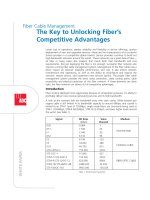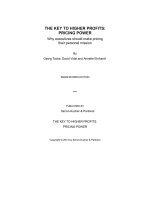The Key to a Winning Sales Message
Bạn đang xem bản rút gọn của tài liệu. Xem và tải ngay bản đầy đủ của tài liệu tại đây (110.32 KB, 3 trang )
inc.com
/>The Key to a Winning Sales Message
Sales messages must show, rather than tell, why customers should buy.
urbancow/iStock
For the past year, I've been rewriting sales messages sent to me by readers of my weekly
newsletter. The mistake that keeps cropping up is telling customers how they should feel,
rather than showing them why they should feel that way. Example:
"This is an exciting new product that's unique in the market!"
The intention behind this kind of phrasing is basically correct. After all, it's easier to sell a
product that's exciting and unique than one that's dull and common. However, as my
grandfather used to say: "Sayin' so don't make it so."
Simply telling the customer that your product is "exciting" or "unique" (or any other positive
adjective) only communicates that YOU feel that way and that YOU would like the customer to
feel that way. The message is all about YOU. Not the customer.
Communicating that your product actually is exciting requires showing them why it's exciting.
To do this, you must present a story or a fact that illustrates (shows) the emotional point
you're trying to make.
For example, suppose you believe your product is "exciting" because it can save customers a
whole lot of money. Simply telling the customer that your product is "exciting" has all the
emotional wallop of a dead mackerel.
By contrast, your customer might actually believe your product is exciting if you show how your
product might positively change the customer's business. For example:
"Based upon my research and experience at companies like [one or two famous firms in the
customer's industry], I believe we can save you somewhere around $1 million a year."
Needless to say, you'll need to back up that claim with additional facts and success stories.
However, rather than telling the customer that your product is "exciting" you've shown the
customer a potential to save $1 million, which actually IS exciting.
Similarly, suppose you believe your product is "unique" because you offer the best service and
customer support in the industry. Simply telling customers that your product is "unique" doesn't
mean diddly-squat.
Instead, you must show the customer exactly why your product is unique and why that
uniqueness is important to the customer. For example:
"Our customers have never experienced system outages that might keep them from taking online
orders because we're the only vendor that offers 24 hour access fail-safe backup."
That's a fairly techie example, but it works because it shows the customer why your product is
unique rather than simply telling the customer that it's so.
With that in mind, it's pretty easy to figure out whether your sales message is any good. Print it
out and, with a red pen, circle every adjective and adverb (i.e. telling). Then underline any facts
that might actually spark an emotional response (i.e. showing).
Now rewrite the message so that it shows rather than tells. Here's a real life example:
By editing out the biz-blab and showing rather than telling, we end up with the following
message, which is far more crisp and compelling:
"Based on my research, I believe we can save you up to 20% on your print services, because
we're part of the world's largest print services company thus can pass the economies of scale
along to you."
The rewritten message will need to be buttressed with some stories about existing customers
and a credible source for the "world's largest" claim. However, it does show, rather than tell, why
the customer should get excited about hiring the vendor.
Geof frey James writes the Sales Source column on Inc.com, the world's most
visited sales-oriented blog. His newly published book is Business to Business Selling:
Power Words and Strategies From the World's Top Sales Experts. @Sales_Source









